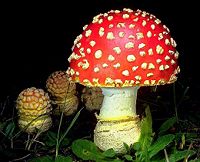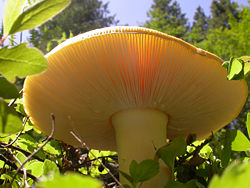Amanita muscaria
For the course duration, the article is closed to outside editing. Of course you can always leave comments on the discussion page. The anticipated date of course completion is May 21, 2009. One month after that date at the latest, this notice shall be removed. Besides, many other Citizendium articles welcome your collaboration! |
| Amanita muscaria | ||||||||||||||
|---|---|---|---|---|---|---|---|---|---|---|---|---|---|---|
 | ||||||||||||||
| Scientific classification | ||||||||||||||
| ||||||||||||||
| Binomial name | ||||||||||||||
| Amanita muscaria (L.) Lam. |
Description and significance
Amanita muscaria, commonly known as the fly agaric, is a psychoactive fungus. Known as the fly agaric for its ability to kill houseflies when combined with milk.[1] The common hallucinogenic compounds found in Amanita muscaria are ibotenic acid (α-amino-3-hydroxy-5-isoxazoleacetic acid) and muscimol (5-(aminomethyl)-3-hydroxyisox-azole).
It is a fairly large mushroom with a bright red cap that ranges from 8-20 cm in diameter. The white spots on the cap are remains of the [universal veil]], a membrane that covers the mushroom at a young age. A partial veil usually forms a skirt like ring on the upper region of the stalk. The stalk or stipe is white or cream in color ranging from 5-20 cm high and 1-2 cm wide. The gills are free or slightly attached and are white in color.[2][3]
Distribution and habitat
The fly agaric mushroom grows in symbiosis with birch, pine, and fir.[4] It can be found in regions of both hemispheres (Alaska, Siberia, Scandinavia, central Europe, North America, Australia, Mexico, the Philippines) and in other regions where the aforementioned trees are located. The fly agaric is also found in the form of fairy rings.[5]
Pharmacology
The two psychoactive agents fount in Amanita Muscaria are Ibotenic acid and Muscimol. Muscarine was originally thought to be the active hallucinogenic ingredient in A. muscaria. It was later found by researchers in the mid 20th century that these effects were caused by Ibotenic acid and Muscimol. There is a much larger amount of Ibotenic acid than Muscimol in the fly agaric, however the Ibotenic acid is decarboxylated when dried out turning it into Muscimol, this provides the psychoactive effect.[6] Other agents found in A. muscaria are Muscarine, Muscazone, Bufotenin (5-OH-DMT), l-hyoscayamine, stizolobinic acid, stizolobic acid, methyltetrahydrocarboline carboxylic acid.[7]
